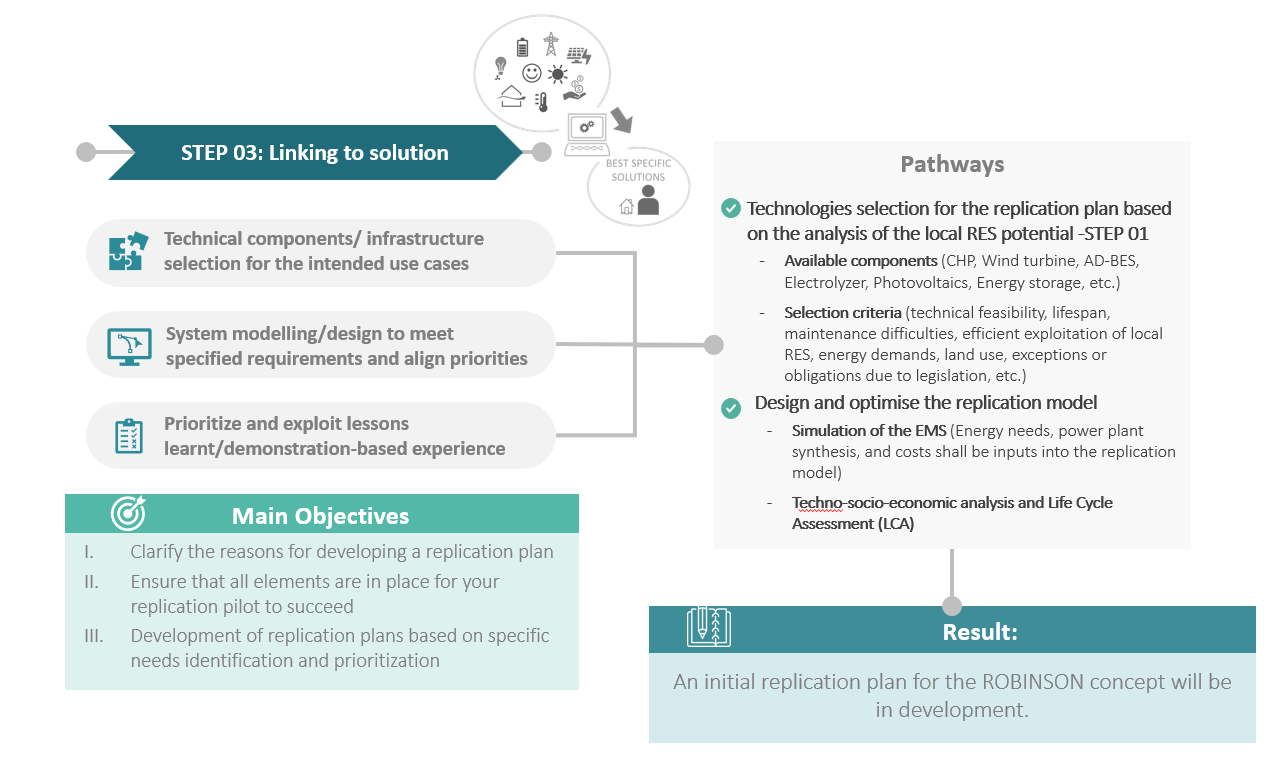Linking to solution

Technical components/infrastructure selection for the intended use cases
This step implies the very existence of the ROBINSON concept since it refers to the ‘Technical components/infrastructure selection for the intended use cases’ that will be integrated after the thorough investigation of the local RES potential of Step 1. This integration refers and precisely describes the specific machinery, installations and facilities that are going to be exploited towards the intended implementation of ROBINSON, considering the specifications of the selected components depend on economic cost, expected returns, expected lifespan, maintenance difficulties, efficient exploitation of the available RES, energy demands, thermal demands, exceptions or obligations due to legislation, etc.
System modelling/design to meet specified requirements and align priorities
Only after the cautious selection of components and infrastructure will the ‘System modelling/design to meet specified requirements and align priorities’ be realistic and efficient. Since ROBINSON may be implemented in an already operating infrastructure, thus already energy and economic resources consuming, it is of high importance the results of modelling to be as accurate as possible. This to convince any prospective adopters of the ROBINSON concept for its efficiency, both in terms of the obvious environmental profits (by harnessing RES potential) and in the accompanying economic terms, since in the long run such an adaptation may be profitable if properly implemented. This is also the fore-step towards the upcoming Business Model since the detailed energy, environmental and economics assessments are going to be therein included. Moreover, based on these assessments, future supervising and control procedures are going to be determined and realized via the Business Model.
Prioritise and exploit lessons learnt/experience gained through the demonstration
Advantages of the system modelling are the parameterization depending on various scenarios and the investigation of separate components’ efficiency, aiming to achieve the best possible results and solutions. To ‘Prioritise and exploit lessons learnt/experience gained through the demonstration’ is crucial for the future steps of replicating the ROBINSON concept. Priorities are dictated by various factors including the legislation differences between locations/countries, also technical differences apply from case to case; diverse energy and/or thermal needs, RES potential, environmental conditions, available budget, constitution of potential stakeholders, etc. Experience is gained both from simulations and feedback of former respective projects, giving the opportunity of dynamic and easy-to-adapt guidelines and decision-making support tools.
Result
This step investigates the technical aspects of replicating the ROBINSON. Possibly the technical aspects are the easiest to predict in such an initiative, rather than the socio-economic ones (as recently proved by the COVID-19 pandemic) or others. Thus, the thorough and as realistic as possible modelling and design for the ROBINSON implementation, is the hands-on linking to the proposed solution by demonstrating results and providing support for various decisions to any key actors.
